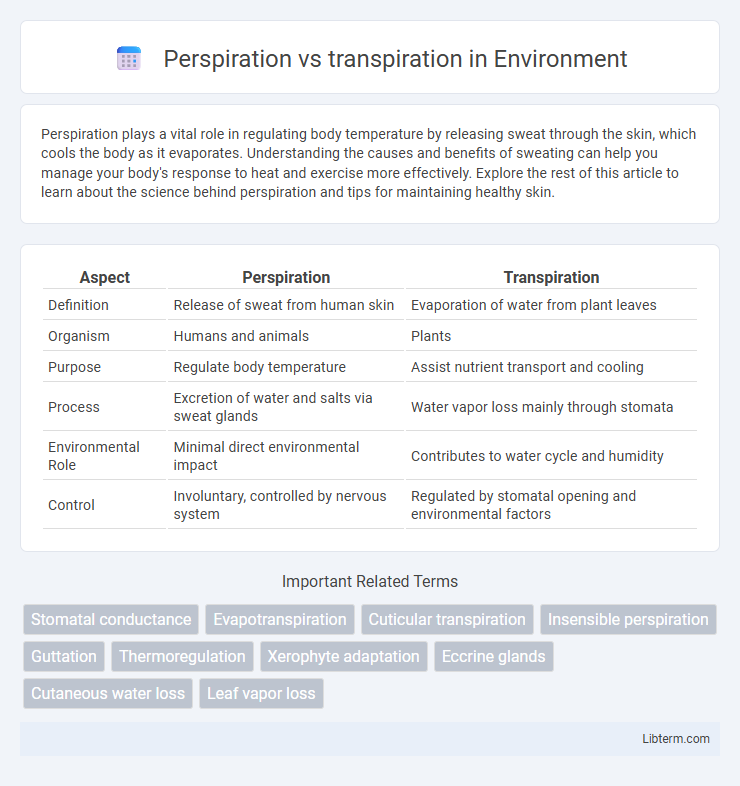Perspiration plays a vital role in regulating body temperature by releasing sweat through the skin, which cools the body as it evaporates. Understanding the causes and benefits of sweating can help you manage your body's response to heat and exercise more effectively. Explore the rest of this article to learn about the science behind perspiration and tips for maintaining healthy skin.
Table of Comparison
| Aspect | Perspiration | Transpiration |
|---|---|---|
| Definition | Release of sweat from human skin | Evaporation of water from plant leaves |
| Organism | Humans and animals | Plants |
| Purpose | Regulate body temperature | Assist nutrient transport and cooling |
| Process | Excretion of water and salts via sweat glands | Water vapor loss mainly through stomata |
| Environmental Role | Minimal direct environmental impact | Contributes to water cycle and humidity |
| Control | Involuntary, controlled by nervous system | Regulated by stomatal opening and environmental factors |
Introduction to Perspiration and Transpiration
Perspiration is the process by which humans and animals release sweat through sweat glands to regulate body temperature and maintain homeostasis. Transpiration refers to the loss of water vapor from plants, primarily through stomata in leaves, which helps in nutrient transport and cooling the plant. Both processes involve water evaporation but serve different biological functions across living organisms.
Defining Perspiration: The Human Process
Perspiration is the physiological process in humans where sweat glands produce and release moisture, primarily water and electrolytes, onto the skin surface to regulate body temperature through evaporative cooling. This involuntary mechanism helps maintain thermal homeostasis during physical exertion or heat exposure. Unlike transpiration in plants, which involves water movement through stomata, perspiration is a critical response controlled by the autonomic nervous system to prevent overheating.
Understanding Transpiration: The Plant Mechanism
Transpiration is the process by which plants release water vapor from stomata in their leaves, regulating temperature and maintaining nutrient flow within the xylem. It differs from perspiration, which is the human body's mechanism to cool down through sweat glands. Understanding transpiration is crucial for optimizing irrigation practices and studying plant responses to environmental stress.
Biological Functions of Perspiration
Perspiration primarily functions to regulate body temperature by releasing sweat from sweat glands, which cools the skin through evaporation. This biological process also aids in excreting metabolic wastes such as urea and salts, maintaining homeostasis. Additionally, perspiration plays a role in skin hydration and protecting the body from overheating during physical exertion or hot environments.
The Role of Transpiration in Plant Physiology
Transpiration is a critical physiological process in plants involving the evaporation of water from stomata, which facilitates nutrient transport from roots to leaves and maintains internal water balance. This process also helps regulate leaf temperature and supports photosynthesis by enabling gas exchange. Unlike perspiration in animals, transpiration is essential for plant growth, nutrient distribution, and overall health in response to environmental conditions.
Key Differences Between Perspiration and Transpiration
Perspiration is the process by which humans and animals release sweat through sweat glands to regulate body temperature, while transpiration is the evaporation of water from plant leaves primarily through stomata, aiding in nutrient transport and cooling. Perspiration involves the excretion of salts and water to maintain thermal homeostasis, whereas transpiration drives the upward movement of water from roots to leaves, facilitating photosynthesis. Unlike perspiration, transpiration is a passive process influenced by environmental factors such as humidity, temperature, and wind.
Environmental Factors Affecting Perspiration and Transpiration
Environmental factors such as temperature, humidity, wind, and soil moisture significantly impact both perspiration in humans and transpiration in plants. Higher temperatures increase the rate of perspiration by stimulating sweat gland activity, while elevated temperature also enhances transpiration by causing greater water vapor loss through plant stomata. Humidity reduces water loss in both processes by decreasing the gradient for evaporation, while wind accelerates water evaporation by removing the water-saturated air layer near the skin or leaf surface.
Importance of Water Regulation in Humans and Plants
Water regulation in humans and plants is vital for maintaining homeostasis and physiological functions. Perspiration in humans controls body temperature and removes waste through sweat glands, preventing overheating and dehydration. Transpiration in plants facilitates nutrient uptake and cooling by releasing water vapor through stomata, ensuring optimal growth and survival.
Applications and Implications in Science and Agriculture
Perspiration in humans plays a critical role in thermoregulation and maintaining homeostasis, essential for medical diagnostics and health monitoring technologies. Transpiration in plants drives nutrient uptake and water movement, directly affecting crop yield and irrigation strategies in agriculture. Understanding these processes informs climate models and enhances sustainable farming practices through improved water management and stress resistance.
Conclusion: Comparing Perspiration and Transpiration
Perspiration is the process of sweating in humans and animals to regulate body temperature, while transpiration refers to the loss of water vapor from plants through stomata for nutrient transport and cooling. Perspiration involves sweat glands and primarily aids in thermoregulation, whereas transpiration involves stomatal openings and is essential for water movement and gas exchange in plants. Understanding these distinctions highlights the unique physiological roles of water loss in animals and plants, emphasizing their adaptation mechanisms to maintain homeostasis and ensure survival.
Perspiration Infographic

 libterm.com
libterm.com